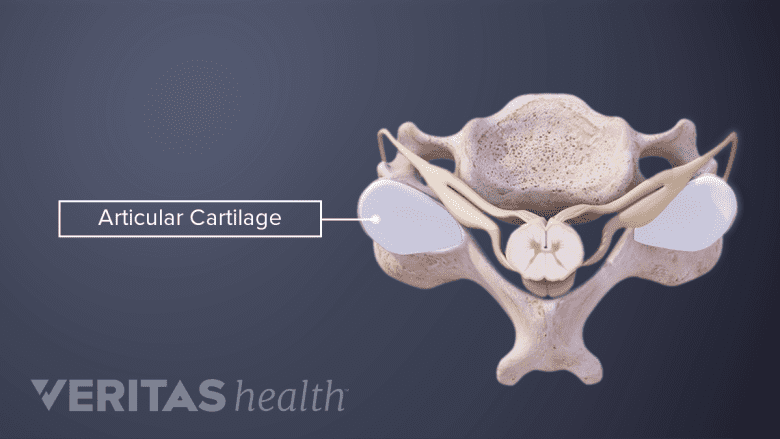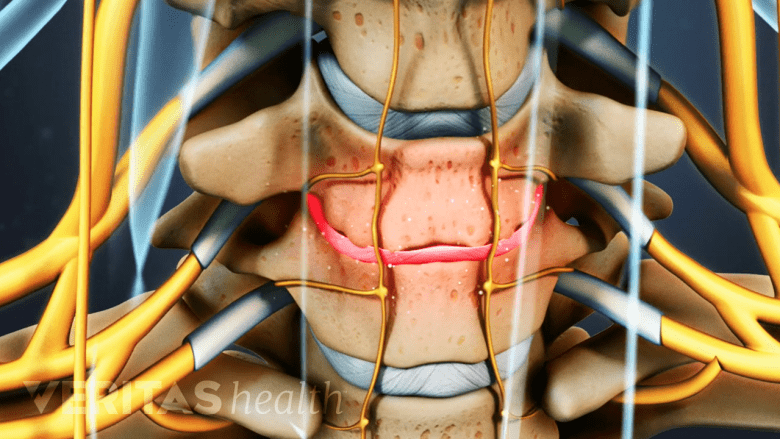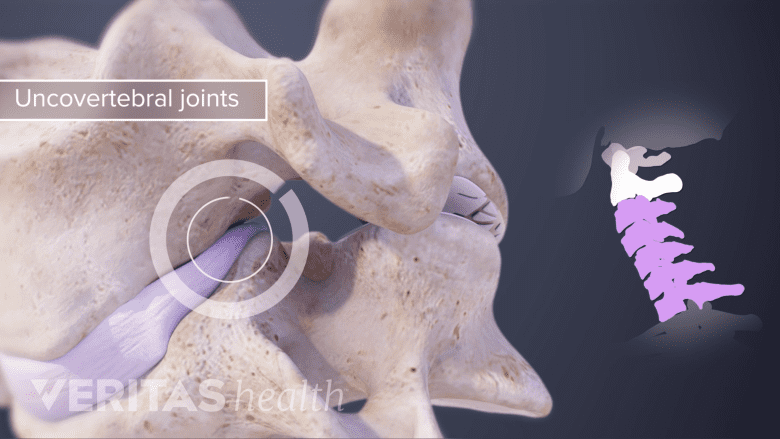There is a three-joint complex that is comprised of the intervertebral disc (located in front) and two small right and left facet joints located in back of each vertebral level. Since the vertebrae are stacked atop each other, these three-joint complexes can be thought of as forming three columns that support the head’s weight pushing directly down on the cervical spine. When one of these columns starts to degenerate, it can alter forces on the others and cause them to also be more likely to degenerate.
In This Article:
- How the Cervical Spine Changes With Age
- How Cervical Disc Degeneration Occurs
- How Cervical Facet Joint Degeneration Occurs
- How Neck Bones and Soft Tissues React to Spinal Degeneration
- When Does the Neck’s Spinal Degeneration Become Painful?
Healthy Facet Joint Composition
A healthy facet has a smooth, slippery layer of articular cartilage that reduces friction between the bony surfaces.
At the back of each vertebral level in the cervical spine are a pair of small facet joints that link adjacent vertebra together. Each facet joint contains:
- Two articular processes. These bony pillars extend from each side of the vertebra toward the back and are the articular bones that join together and move within the joint. A superior (upper) articular process comprises the top part of the joint, and the inferior (lower) articular process comprises the bottom part.
- Cartilage. At the edge of each articular process is a layer of smooth cartilage that prevents the bones from rubbing directly against each other.
- Joint capsule. This capsule, made of strong fibrous connective tissue, encloses the joint space and attaches to the two articular processes.
- Synovial membrane. This membrane, also called the synovium, lines the inside of the joint capsule. It produces synovial fluid to keep the joint nourished, lubricated, and moist to minimize friction between the joint’s two bones and facilitate easy movements.
See Facet Joint Anatomy Animation
These are not all of the parts of a facet joint, but these are the main ones discussed in this article.
Facet Joint Degeneration
Age-related wear and tear of the vertebrae leads to disc degeneration.
As a facet joint ages, its cushioning cartilage dries out, gets small cracks and starts to wear down. Small tears and/or inflammation can also occur in the joint capsule and synovial membrane, which may affect the production of synovial fluid that helps keep the joint nourished and lubricated.
See Facet Joint Disorders and Back Pain
Once cartilage starts to wear away, it either does not regenerate or regenerates insufficiently. Initially, the loss of cartilage can result in excessive motion in the joint (hypermobility), but over time inflammation, osteoarthritis, and bone spur growth (described on the next page) cause the joint to stiffen and have less mobility.
Structural Problems Caused by Degenerating Facet Joints
The degeneration of facet joints results in the narrowing of the foramen, causing foraminal stenosis.
Due to the close proximity and interdependence of the three-joint complex comprised of the disc and two facet joints at each vertebral level, a degenerating facet joint can cause structural problems similar to a degenerating disc. Even if only one facet joint starts experiencing degeneration, that will transfer different forces to the other facet and disc at that vertebral level—altering their mechanics and increasing their risk for further degeneration as well. These changes in loads at one vertebral level can also start to affect other vertebral levels.
See Symptoms and Diagnosis of Facet Joint Disorders
As the facet joint moves out of position and stiffens, there is an increased likelihood for:
- The bony tunnel, called the foramen, on either side of the vertebral level to narrow and pinch a nerve root (foraminal stenosis)
- Bone, disc, or soft tissue to go into the central canal and push against the spinal cord (cervical stenosis with myelopathy)
Significant facet joint degeneration is always accompanied by significant disc degeneration, and vice versa. In rare cases, facet joint and disc degeneration could lead to a vertebra slipping over the vertebra beneath it (cervical spondylolisthesis).
Uncovertebral Joints
Uncovertebral joints are a common location of degeneration and growth of bone spurs.
It should also be noted that in the developed cervical spine at levels C3 through C7, on either side of the disc is an uncovertebral joint, also known as Luschka’s joint. This joint develops by age 10 and is comprised of a bony pillar (uncinate process) that grows upward and interfaces (meets) with an indentation in the above vertebra.
While facet joints are more critical to the cervical spine’s movements, the uncovertebral joints are also a common location for degeneration and bone spur growth, which can cause many of the same problems as a degenerating facet joint, such as foraminal stenosis.
See Bone Spur Causes









